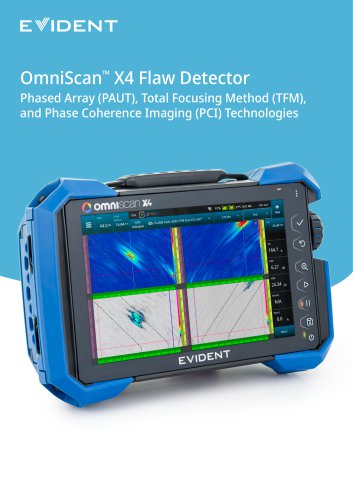 Website:
Evident - Inspection Technologies
Website:
Evident - Inspection Technologies
Group: EVIDENT
Catalog excerpts

Your Vision, Our Future Inverted Metallurgical Microscope Advanced Microscopy Solutions for Metallurgy Inspection
Open the catalog to page 1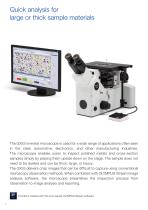
Quick analysis for large or thick sample materials The GX53 inverted microscope is used for a wide range of applications often seen in the steel, automotive, electronics, and other manufacturing industries. The microscope enables users to inspect polished metals and cross-section samples simply by placing them upside down on the stage. The sample does not need to be leveled and can be thick, large, or heavy. The GX53 delivers crisp images that can be difficult to capture using conventional microscopy observation methods. When combined with OLYMPUS Stream image analysis software, the...
Open the catalog to page 2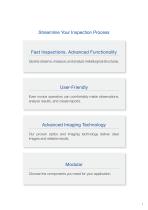
Streamline Your Inspection Process Fast Inspections, Advanced Functionality Quickly observe, measure, and analyze metallurgical structures. User-Friendly Even novice operators can comfortably make observations, analyze results, and create reports. Advanced Imaging Technology Our proven optics and imaging technology deliver clear images and reliable results. Modular Choose the components you need for your application.
Open the catalog to page 3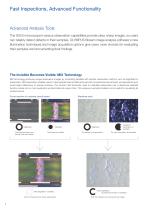
Fast Inspections, Advanced Functionality Advanced Analysis Tools The GX53 microscope’s various observation capabilities provide clear, sharp images, so users can reliably detect defects in their samples. OLYMPUS Stream image analysis software's new illumination techniques and image acquisition options give users more choices for evaluating their samples and documenting their findings. The Invisible Becomes Visible: MIX Technology MIX technology produces unique observation images by combining darkfield with another observation method, such as brightfield or polarization. MIX observation...
Open the catalog to page 4
Easily Create Panoramic Images: Instant MIA Create All-in-Focus Images: EFI With multiple image alignment (MIA), users can stitch images together quickly and simply by moving the XY knobs on the manual stage—a motorized stage is optional. OLYMPUS Stream software uses pattern recognition to generate a panoramic image, which is suitable for inspections of carburizing and metal-flow conditions. OLYMPUS Stream software’s extended focus imaging (EFI) function captures images of samples whose height extends beyond the depth of focus. EFI stacks these images together to create a single...
Open the catalog to page 5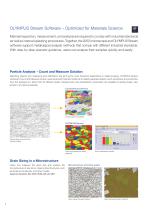
OLYMPUS Stream Software – Optimized for Materials Science Material inspection, measurement, and analysis are required to comply with industrial standards as well as internal operating procedures. Together, the GX53 microscope and OLYMPUS Stream software support metallurgical analysis methods that comply with different industrial standards. With step-by-step operator guidance, users can analyze their samples quickly and easily. Particle Analysis – Count and Measure Solution Detecting objects and measuring size distribution are among the most important applications in digital imaging. OLYMPUS...
Open the catalog to page 6
Evaluating Graphite Nodularity The software can be used to evaluate the graphite nodularity and content in cast iron samples (nodular and vermicular). The form, distribution, and size of graphite nodes can be classified. Supported standards: ISO, NF, ASTM, KS, JIS, GB/T Ductile cast iron showing nodular graphite Rating Nonmetallic Inclusion Content in High-Purity Steel Classify nonmetallic inclusions using an captured image of Steel with nonmetallic inclusions the worst field or inclusion that you have manually located on the sample. Supported standards: ISO, EN, ASTM, DIN, JIS, GB/T, UNI...
Open the catalog to page 7
A Design That Emphasizes User Comfort The microscope’s ergonomic design helps users stay comfortable while they work, contributing to a more efficient inspection. When used with OLYMPUS Stream software, operators can easily acquire images of diverse samples, conduct a variety of analyses, and generate professional reports. Maintain a comfortable posture The tilting observation tube’s extensive range and adjustable eyepoint enable operators to sit or stand at the microscope in a comfortable posture. Observe large, heavy samples Samples up to 5 kg can be inspected simply by placing the...
Open the catalog to page 8
Easily Restore Microscope Settings: Coded Hardware Coded functions integrate the microscope’s hardware settings with OLYMPUS Stream image analysis software. The observation method, illumination intensity, and magnification can be recorded by the software and stored with the associated images. Since the settings can easily be reproduced, different operators can conduct the same quality inspections with limited training. Retrieve the device settings with OLYMPUS Stream software Operator B Restore Device Status menu All operators can use the same settings. Different operators use different...
Open the catalog to page 9
Advanced Imaging Technology Proven optics and digital imaging technology deliver quality inspection data Olympus’ history of developing high-quality optics and advanced imaging capabilities has led to quality microscopes that offer exceptional measurement accuracy. Reliable Optical Performance: Wavefront Aberration Control Consistent Color Temperature: High-Intensity White LED Illumination The optical performance of objective lenses directly impacts the quality of the observation images and analysis results. Olympus UIS2 high-magnification objectives are designed to minimize wavefront...
Open the catalog to page 10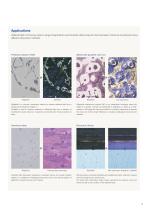
Applications Reflected light microscopy spans a range of applications and industries. Below are just a few examples of what can be achieved using different observation methods. Polished sample of AlSi Spheroidal graphite cast iron Brightfield is a common observation method to observe reflected light from a sample by illuminating it straight on. Darkfield is used to observe scattered or diffracted light from a sample, so imperfections clearly stand out. Inspectors can identify even minute scratches or flaws. Differential interference contrast (DIC) is an observation technique where the...
Open the catalog to page 11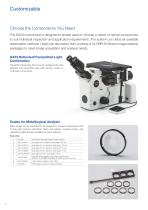
Choose the Components You Need The GX53 microscope is designed to enable users to choose a variety of optical components to suit individual inspection and application requirements. The system can utilize all available observation methods. Users can also select from a variety of OLYMPUS Stream image analysis packages to meet image acquisition and analysis needs. GX53 Reflected/Transmitted Light Combination The GX53 microscope frame can be configured for both reflected and transmitted light with manual, coded, or motorized components. Scales for Metallurgical Analysis Glass scales can be...
Open the catalog to page 12All Evident - Inspection Technologies catalogs and technical brochures
-
OmniScan X4
8 Pages
-
39DL PLUS
12 Pages
-
IPLEX GX/GT
8 Pages
-
More Solutions, More Flexibility
20 Pages
-
35 RDC
2 Pages
-
Scanners and Accessories
36 Pages
-
Remote Visual Inspections
16 Pages
-
OLYMPUS LC30
2 Pages
-
TRIPLE KIT Generation 2
2 Pages
-
CIX100
16 Pages
-
OLYMPUS CIX Series
24 Pages
-
MX63/MX63L
20 Pages
-
SWTLU-C
4 Pages
-
OLS5000
42 Pages
-
DELTA Professional
2 Pages
-
BTX II, TERRA
2 Pages
-
MagnaFORM
2 Pages
-
EX Series Instruments
4 Pages
-
Vanta Overview
2 Pages
-
Vanta Overview
3 Pages
-
Portable XRD
2 Pages
-
TOFD Solution
4 Pages
-
BondMaster 600
5 Pages
-
Triple Kit Generation 2
2 Pages
-
45MG
12 Pages


